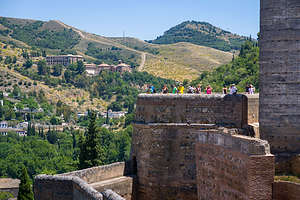- Home
- About
- Map
- Trips
- Bringing Boat West
- Migration West
- Solo Motorcycle Ride
- Final Family XC Trip
- Colorado Rockies
- Graduates' XC Trip
- Yosemite & Nevada
- Colorado & Utah
- Best of Utah
- Southern Loop
- Pacific Northwest
- Northern Loop
- Los Angeles to NYC
- East Coast Trips
- Martha's Vineyard
- 1 Week in Quebec
- Southeast Coast
- NH Backpacking
- Martha's Vineyard
- Canadian Maritimes
- Ocracoke Island
- Edisto Island
- First Landing '02
- Hunting Island '02
- Stowe in Winter
- Hunting Island '01
- Lake Placid
- Chesapeake
- Provincetown
- Hunting Island '00
- Acadia in Winter
- Boston Suburbs
- Niagara Falls
- First Landing '99
- Cape Hatteras
- West Coast Trips
- Burning Man
- Utah Off-Roading
- Maui
- Mojave 4WD Course
- Colorado River Rafting
- Bishop & Death Valley
- Kauai
- Yosemite Fall
- Utah Off-Road
- Lost Coast
- Yosemite Valley
- Arizona and New Mexico
- Pescadero & Capitola
- Bishop & Death Valley
- San Diego, Anza Borrego, Joshua Tree
- Carmel
- Death Valley in Fall
- Yosemite in the Fall
- Pacific Northwest
- Utah Off-Roading
- Southern CA Deserts
- Yosemite & Covid
- Lake Powell Covid
- Eastern Sierra & Covid
- Bishop & Death Valley
- Central & SE Oregon
- Mojave Road
- Eastern Sierra
- Trinity Alps
- Tuolumne Meadows
- Lake Powell Boating
- Eastern Sierra
- Yosemite Winter
- Hawaii
- 4WD Eastern Sierra
- 4WD Death Valley +
- Southern CA Deserts
- Christmas in Tahoe
- Yosemite & Pinnacles
- Totality
- Yosemite & Sierra
- Yosemite Christmas
- Yosemite, San Diego
- Yosemite & North CA
- Seattle to Sierra
- Southwest Deserts
- Yosemite & Sierra
- Pacific Northwest
- Yosemite & South CA
- Pacific Northwest
- Northern California
- Southern Alaska
- Vancouver Island
- International Trips
- Index
- Tips
- Books
- Photos/Videos
- Search
- Contact
Granada, Spain
Monday, May 27, 2019 - 1:00pm by Lolo
200 miles and 4 hours from our last stop - 2 night stay
Travelogue
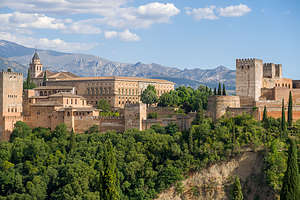 View of Alhambra from AlbaicinThe 4-hour drive inland to Granada was beautiful, with olive trees as far as the eye can see. In fact, I learned afterwards that there are 250 million olive trees in Spain and that they produce almost half of the world’s olive oil. I used to always think Italy when buying olive oil, but Spain produces three times as much and makes some of the best in the world.
View of Alhambra from AlbaicinThe 4-hour drive inland to Granada was beautiful, with olive trees as far as the eye can see. In fact, I learned afterwards that there are 250 million olive trees in Spain and that they produce almost half of the world’s olive oil. I used to always think Italy when buying olive oil, but Spain produces three times as much and makes some of the best in the world.
The scenery got even more beautiful and surreal as we got closer to Granada and passed through an area that I later learned is called the Barrio de Cuevas or the Neighbourhood of Caves, where homes are built into the red craggy hills. It was like a Hobbit village with front doors cut into the side of the rock and tiny white chimneys poking out of the hills. Known as troglodytes, people have been living in these caves for centuries.
The backdrop of the Sierra Nevada mountains behind them certainly didn’t hurt the view.
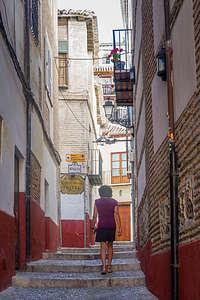 Lolo strolling up the steps of the AlbaicinSoon we were in Granada, home to Spain’s most visited tourist attraction. I had been warned by friends that have been there that it is a selfie-stick madhouse, but we figured we just had to do it. When I tried to buy 14 € General Admission tickets a month before our trip, they were sold out, so I bought 46 € tickets through Nhue tours for a 3-hour, small group (less than 20), English speaking tour of the Alhambra, Generalife, Alcazaba and Nasrid Palaces. Rick Steve had emphasized to make sure the tour included the Nasrid Palaces, as that is the highlight.
Lolo strolling up the steps of the AlbaicinSoon we were in Granada, home to Spain’s most visited tourist attraction. I had been warned by friends that have been there that it is a selfie-stick madhouse, but we figured we just had to do it. When I tried to buy 14 € General Admission tickets a month before our trip, they were sold out, so I bought 46 € tickets through Nhue tours for a 3-hour, small group (less than 20), English speaking tour of the Alhambra, Generalife, Alcazaba and Nasrid Palaces. Rick Steve had emphasized to make sure the tour included the Nasrid Palaces, as that is the highlight.
While doing my research, I had learned that campers can actually park overnight in the Alhambra parking lot. I was skeptical at first, but several non-official Alhambra websites seemed to confirm that it was possible. However, when we read how difficult it is to navigate through the streets of Granada, we got cold feet and decided to stay at an official campground called Reina Isabel on the outskirts of the city where we could catch a bus into the Granada Old Town, where all the tourist action is.
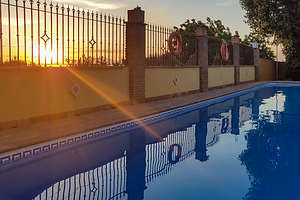 Pool at Camping Reina IsabelThe campground was lovely, and had a beautiful pool - minus the giant slides and fake alligators of La Marina - perfect for dipping into after a long, hot day of sightseeing. The Andalucian area of Spain gets very hot in the summer.
Pool at Camping Reina IsabelThe campground was lovely, and had a beautiful pool - minus the giant slides and fake alligators of La Marina - perfect for dipping into after a long, hot day of sightseeing. The Andalucian area of Spain gets very hot in the summer.
Our tickets to the Alhambra were for the following day at noon, but since we still had plenty of time today, we decided to take the bus and explore the Old Town surrounding the Alhambra. But not before taking a refreshing dip in the pool.
The bus dropped us off at the Palacio de Congresos, about a mile and a half from the Alhambra. Since that was tomorrow’s activity, we headed instead to the Albaicin, the old Moorish quarter of the city on a hill overlooking the Alhambra. Remember, Granada was under Islamic control until the Reconquista in 1492, and the Alhambra was the last stronghold of the Moorish kingdom in Spain.
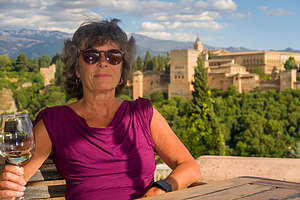 Lolo enjoying her wine from atop the AlbaicinOur goal was to walk up to the top of the hill to the Plaza San Nicolas, said to be one of the most romantic views in all of Europe, especially at sunset when the Alhambra glows red in the evening light. Not knowing exactly how to get there, we started at the River Darro and just kept walking up along the maze of narrow, winding cobblestone streets.
Lolo enjoying her wine from atop the AlbaicinOur goal was to walk up to the top of the hill to the Plaza San Nicolas, said to be one of the most romantic views in all of Europe, especially at sunset when the Alhambra glows red in the evening light. Not knowing exactly how to get there, we started at the River Darro and just kept walking up along the maze of narrow, winding cobblestone streets.
Finally, we heard music and found a lovely plaza lined with cafes and restaurants at the top of the hill. The view of the Alhambra below with the Sierra Nevada backdrop did not disappoint.
Even better though was sipping wine on the terrace of the El Huerto de Juan Ranas with an uninterrupted view of the Alhambra and Generalife below. It was absolutely breathtaking. I tried to take tiny sips to prolong the experience.
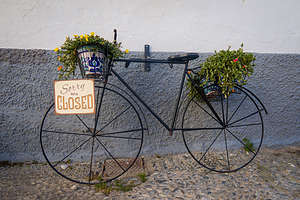 Strolling in the AlbaicinAfterwards we walked back down through a different series of narrow alleys, through the Sacromonte, or gypsy cave quarter, where the best flamenco shows can be found. Unfortunately, we were a bit too early for that, so we continued down and along the River Darro stopping to eat at one of its many restaurants.
Strolling in the AlbaicinAfterwards we walked back down through a different series of narrow alleys, through the Sacromonte, or gypsy cave quarter, where the best flamenco shows can be found. Unfortunately, we were a bit too early for that, so we continued down and along the River Darro stopping to eat at one of its many restaurants.
In retrospect, I enjoyed exploring the Albaicin even better than touring the Alhambra because it was uncrowded and felt more real. Besides the unimpeded views of the Alhambra’s exterior were in the evening light far exceeded looking over and around the hoards of people touring its interior. Still, they both are very much worth the effort.
The next morning, we took the bus back into the Old Town and wandered up the steep hill to the Alhambra ticket office where our tour would commence at noon. We had some time to kill, so we wandered around further up the hill, eventually stumbling upon a cemetery called the Cementerio de San José de Granada.
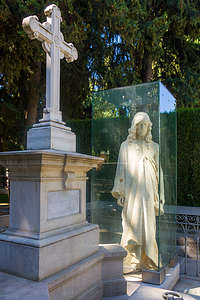 Cementerio de San José de GranadaFor some reason, and I don’t think I’m particularly morbid, I like wandering around cemeteries. They are very peaceful and often have very interesting art. One of the more noteworthy ones was a larger than life-size Jesus enclosed in a glass box.
Cementerio de San José de GranadaFor some reason, and I don’t think I’m particularly morbid, I like wandering around cemeteries. They are very peaceful and often have very interesting art. One of the more noteworthy ones was a larger than life-size Jesus enclosed in a glass box.
At noon we met up with our tour guide and group and spent three very informative hours exploring the various parts of the Alhambra.
There are entire books about the Alhambra, so I am not going to even attempt to go into a detailed description of it, as I would in no way be able to do it justice. To really understand it, you have to experience first hand, which 8,000 people do each and every day.
However, very very briefly, the Alhambra is not just one building, but rather a palace and fortress complex of buildings perched atop a rocky hill overlooking the city of Granada. Built by the Nasrid sultans between 1238 and 1358, during the reign of Ibn al-Ahmar, the founder of the Nasrid dynasty, it served as the palace and fortress of the Moorish (Islamic) monarchs. Its name, which means “red castle” in Arabic, comes from the reddish color of its outer walls that were particularly vibrant when it was first built.
The Nasrids were the last Muslim Dynasty in Spain. They surrendered to the Christians during the Catholic Reconquista in 1492, ending almost 800 years of Islamic Rule in the Iberian peninsula.
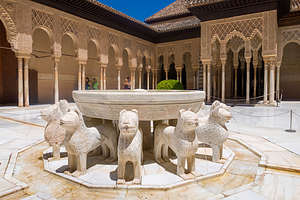 Courtyard of the Palace of the LionsThere are four major sights within the Alhambra complex:
Courtyard of the Palace of the LionsThere are four major sights within the Alhambra complex:
- Nasrid Palaces - exquisite Moorish palace and the stunning centerpiece of the Alhambra
The complex was originally divided into 3 sections: the Mexuar, or royal offices, where justice was administered and state affairs were carried out; the Palacio de Comares, which was the official residence of the king; and the Palace of the Lions, which was the private area of the palace, where the Harem was located.
My favorite parts of the Nasrid Palace include:
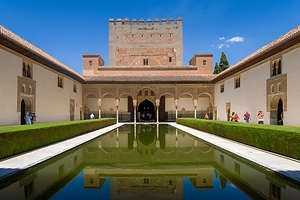 Courtyard of the MyrtlesThe Court of the Myrtles, an elegant patio named for the myrtle hedges that surround the central pond and the bright green colour of which contrasts with the white marble of the patio. It was also called the Patio of the Pond or the Reservoir. The apartments of the sultan’s women looked over this courtyard: two apartments for wives on either side, and a dorm for the concubines at the far end.
Courtyard of the MyrtlesThe Court of the Myrtles, an elegant patio named for the myrtle hedges that surround the central pond and the bright green colour of which contrasts with the white marble of the patio. It was also called the Patio of the Pond or the Reservoir. The apartments of the sultan’s women looked over this courtyard: two apartments for wives on either side, and a dorm for the concubines at the far end. At the north end of the courtyard is the 45 meter high Comares Tower, the highest tower in the Alhambra. The Comares Palace was the official residence of the king and within it is the beautiful Hall of the Ambassadors, which functioned as the throne room. It was here that the sultan sat upon his throne receiving foreign emissaries.
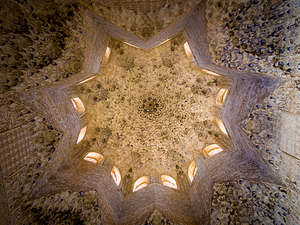 The Seven Heavens of the Islamic Paradise in the Hall of the AmbassadorsIt was the most majestic hall of the palace. Its ceiling is a representation of the Seven Heavens of the Islamic Paradise, with God's throne on the eighth heaven. The hall is completely covered by decorative inscriptions in Arabic script.Muslims avoided making images of living creatures, as that was thought to be God’s work alone. One particular phrase, “only Allah is victorious” is repeated 9,000 ties throughout the palace.
The Seven Heavens of the Islamic Paradise in the Hall of the AmbassadorsIt was the most majestic hall of the palace. Its ceiling is a representation of the Seven Heavens of the Islamic Paradise, with God's throne on the eighth heaven. The hall is completely covered by decorative inscriptions in Arabic script.Muslims avoided making images of living creatures, as that was thought to be God’s work alone. One particular phrase, “only Allah is victorious” is repeated 9,000 ties throughout the palace. According to legend two very significant historical events took place in this room in 1492: the last Moorish king surrendered the city of Granada to the Catholic Monarchs thereby ending the 700-year Reconquista, and Christopher Columbus convinced the Catholic Monarchs to give their approval for his expeditions to the Indies. Those are two pretty big historically game-changing events.
However, my overall favorite part of the Nasrid Palaces was the courtyard of the Palace of the Lions, where 12 marble lions hold up a gurgling fountain. The courtyard layout uses the proportions of the golden ratio. Its 124 slender columns are placed in such a way that they are symmetrical on numerous axes.
- Generalife Gardens - the sultans’ summer palace and lovely manicured gardens and orchards
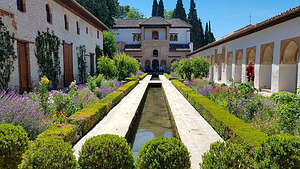 Generalife Gardens of the AlhambraA simple one-way path leads through the manicured gardens, past ponds and fountains, to the sultan’s bright white summer palace. The gardens were irrigated by a royal aqueduct which diverted water from the Darro River into the Alhambra.
Generalife Gardens of the AlhambraA simple one-way path leads through the manicured gardens, past ponds and fountains, to the sultan’s bright white summer palace. The gardens were irrigated by a royal aqueduct which diverted water from the Darro River into the Alhambra. In contrast to the decorativeness of the Nasrid Palace, the buildings in the Generalife are all quite solid and simple. The emphasis was on the fountains and the gardens.
The Moorish kings considered this garden to be the closest thing on earth to the Quran’s description of heaven. The Generalife became a leisure place for them when they wanted to get away from the official affairs of the palace.
- Alcazaba Fort - remains of the 13th-century citadel.
- Charles V’s Palace - the Christian Renaissance palace built within the Alhambra after the Reconquista.
Charles V very much respected the Alhambra’s beauty, so he built a modern Renaissance palace for official functions, but used the existing Nasrid Palaces as his royal residence. The palace, which was designed by Pedro Machua, a pupil of Michelangelo’s, has a unique circle-within-a square design. The palace is square, but within its center is a roofless, two-tiered circular courtyard ringed by 32 marble columns.
This is actually the oldest part of the Alhambra complex. Built in the 13th-century, it once defended a medina (town) of 2,000 Muslims living within its walls. A winding staircase leads to the top of a tower to Alhambra’s best viewpoint
Our tour guide was very adept at steering us into less crowded areas of the complex during our tour making it a very pleasant and educational experience.
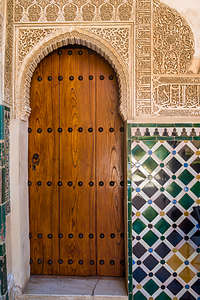 Lovely tilework and decorative Arabric script in the AlhambraHe also emphasized that if it wasn’t for two people, we probably would not be experiencing the history and beauty of the Alhambra today:
Lovely tilework and decorative Arabric script in the AlhambraHe also emphasized that if it wasn’t for two people, we probably would not be experiencing the history and beauty of the Alhambra today:
- A wounded Spanish soldier during the Napoleonic Wars - In 1812, Napoleon’s troops invaded Granada and seized the Alhambra, looting and damaging large portions of it. Their attempt to blow up the palace was thwarted by a wounded soldier left behind in the palace, who single handedly diffused the bomb saving this beautiful building for future generations.
- Washington Irving - the Alhambra’s remarkable beauty and historical significance were not appreciated until Irving visited the Alhambra, fell in love with its architecture and history, and wrote Tales of the Alhambra, a collection of stories which brought this incredible site to the world’s attention, thereby preserving it for future generations.
So often in history, it is the actions of a few brave and insightful people that change the course of history. Those are the stories I love to hear.
Exhausted from our full day of touring in the heat of a Granada summer, we caught our bus back to Camping Reina Isabel and sunbathed and swam in the lovely pool beneath the hot Andalusian sun. .
Description
While I will not attempt to do an in-depth description of all Granada has to offer -- there are numerous guidebooks to do just that -- the following are some of the interesting sites that we enjoyed:
Alhambra - Spain's most visited attraction:
- Monumental complex of buildings atop a rocky hill, overlooking the city of Granada that was once the palace and fortress of the Moorish monarchs. It was built between 1238 and 1358, during the reign of Ibn al-Ahmar, the founder of the Nasrid dynasty.
- Its name, which means “red castle” in Arabic comes from the reddish color of its outer walls that were particularly vibrant when it was first built.
- The Nasrids were the last Muslim Dynasty in Spain to surrender to the Christians during the Catholic Reconquista in 1492, ending almost 800 years of Islamic Rule in the Iberian peninsula.
- Today, the Alhambra attracts 8,000 visitors a day and tickets must be purchased well in advance: www.tickets.alhambra-patronato.es
- The Alhambra consists of four sights clustered atop the hill:
- Palacios Nazaries - exquisite Moorish palace and the stunning centerpiece of the palace complex
- Charles V’s Palace - the Christian Renaissance palace built within the Alhambra after the Reconquista
- Generalife Gardens - the sultans’ summer palace and lovely manicured gardens with pathways, patios, pools, and fountains
- Alcazaba Fort - remains of the 13th-century citadel. A winding staircase leads to the top of a tower to Alhambra’s best viewpoint
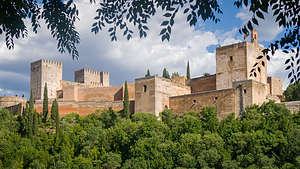 View of Alhambra from Albaicin
View of Alhambra from Albaicin
Albaicin - Medieval Moorish town dating back to the Nasrid Kingdom of Granada
- UNESCO site
- Located atop a hill overlooking the Alhambra
- Lovely narrow alleyways and small squares to wander through
- Plaza San Nicolas - great panoramic views
- Terrace of El Huerto de Juan Ranas - great place to sip wine with an uninterrupted view of the Alhambra and Generalife below.
Sacromonte - gypsy cave quarter with best flamenco guitarists, dancers and singers
- ‹ previous
- 6 of 20
- next ›
Granada location map in "high definition"
Javascript is required to view this map.

